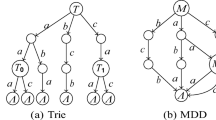Abstract
A table constraint is explicitly represented as its set of solutions or non-solutions. This ad hoc (or extensional) representation may require space exponential to the arity of the constraint, making enforcing GAC expensive. In this paper, we address the space and time inefficiencies simultaneously by presenting the mddc constraint. mddc is a global constraint that represents its (non-)solutions with a multi-valued decision diagram (MDD). The MDD-based representation has the advantage that it can be exponentially smaller than a table. The associated GAC algorithm (called mddc) has time complexity linear to the size of the MDD, and achieves full incrementality in constant time. In addition, we show how to convert a positive or negative table constraint into an mddc constraint in time linear to the size of the table. Our experiments on structured problems, car sequencing and still-life, show that mddc is also a fast GAC algorithm for some global constraints such as sequence and regular. We also show that mddc is faster than the state-of-the-art generic GAC algorithms in Gent et al. (2007), Lecoutre and Szymanek (2006), Lhomme and Régin (2005) for table constraint.
Similar content being viewed by others
References
Beldiceanu, N., & Contejean, E. (1994). Introducing global constraints in CHIP. Journal of Mathematical and Computer Modelling, 20(12), 97–123.
Bessière, C., & Régin, J.-C. (1997). Arc consistency for general constraint networks: Preliminary results. In International joint conference on artificial intelligence (pp. 398–404).
Bessière, C., & Régin, J.-C. (1999). Enforcing arc consistency on global constraints by solving subproblems on the fly. In International Conference on Principles and Practice of Constraint Programming (pp. 103–117).
Bessière, C., Régin, J.-C., Yap, R. H. C., & Zhang, Y. (2005). An optimal coarse-grained arc consistency algorithm. Artificial Intelligence, 165(2), 165–185.
Bollig, B., & Wegener, I. (1996). Improving the variable ordering of OBDDs is NP-complete. IEEE Transactions on Computers, 45(9), 993–1002.
Briggs, P., & Torczon, L. (1993). An efficient representation for sparse sets. ACM Letters on Programming Languages and Systems, 2(1–4), 59–69.
Bryant, R. E. (1986). Graph-based algorithms for Boolean function manipulation. IEEE Transactions on Computers, 35(8), 667–691.
Carlsson, M. (2006). Filtering for the case constraint. Talk given at Advanced School on Global Constraints.
Carlsson, M., et al. (2005). SICStus Prolog User’s Manual. Swedish Institute of Computer Science, release 3.12.3 ed. http://www.sics.se/sicstus/.
Cheng, K. C. K., & Yap, R. H. C. (2006a). Applying ad-hoc global constraints with the case constraint to Still-life. Constraints, 11(2–3), 91–114.
Cheng, K. C. K., & Yap, R. H. C. (2006b). Maintaining generalized arc consistency on ad-hoc n-ary boolean constraints. In European conference on artificial intelligence (pp. 78–82).
Cheng, K. C. K., & Yap, R. H. C. (2008). Maintaining generalized arc consistency on ad hoc r-ary constraints. In International conference on principles and practice of constraint programming (pp. 509–523).
Dincbas, M., Simonis, H., & van Hentenryck, P. (1988). Solving the car-sequencing problem in constraint logic programming. In European conference on artificial intelligence (pp. 290–295).
Eén, N., & Sörensson, N. (2006). Translating pseudo-boolean constraints into SAT. Journal on Satisiability, Boolean Modeling and Computation, 2, 1–26.
Gent, I. P., Jefferson, C., Miguel, I., & Nightingale, P. (2007). Data structures for generalized arc consistency for extensional constraints. In National conference on artificial intelligence.
Guy, R., Conway, J. H., & Berlekamp, E. (1982). Winning ways: for your mathematical plays (Vol. 2). London: Academic Press.
Katsirelos, G., & Walsh, T. (2007). A compression algorithm for large arity extensional constraints. In International conference on principles and practice of constraint programming (pp. 379–393).
Lecoutre, C. (2008). Optimization of simple tabular reduction for table constraints. In International conference on principles and practice of constraint programming (pp. 128–143).
Lecoutre, C., & Szymanek, R. (2006). Generalized arc consistency for positive table constraints. In International conference on principles and practice of constraint programming (pp. 284–298).
Lhomme, O. (2004). Arc-consistency filtering algorithm for logical combinations of constraints. In International conference on integration of AI and OR techniques in constraint programming for combinatorial optimization problems (pp. 209–224).
Lhomme, O., & Régin, J.-C. (2005). A fast arc consistency algorithm for n-ary constraints. In National conference on artificial intelligence (pp. 405–410).
Mackworth, A. K. (1977). On reading sketch maps. In International joint conference on artificial intelligence (pp. 598–606).
Pesant, G. (2004). A regular language membership constraint for finite sequences of variables. In International conference on principles and practice of constraint programming (pp. 482–495).
Srinivasan, A., Kam, T., Malik, S., & Brayton, R. (1990). Algorithms for discrete function manipulation. In Computer aided design (pp. 92–95).
Ullmann, J. R. (2007). Partition search for non-binary constraint satisfaction. Information Science, 177, 3639–3678.
van Hoeve, W.-J., Pesant, G., Rousseau, L.-M., & Sabharwal, A. (2006). Revisiting the sequence constraint. In International conference on principles and practice of constraint programming (pp. 620–634).
Xu, K., Boussemart, F., Hemery, F., & Lecoutre, C. (2005). A simple model to generate hard satisfiable instances. In International joint conference on artificial intelligence (pp. 337–342).
Author information
Authors and Affiliations
Corresponding author
Rights and permissions
About this article
Cite this article
Cheng, K.C.K., Yap, R.H.C. An MDD-based generalized arc consistency algorithm for positive and negative table constraints and some global constraints. Constraints 15, 265–304 (2010). https://doi.org/10.1007/s10601-009-9087-y
Published:
Issue Date:
DOI: https://doi.org/10.1007/s10601-009-9087-y




